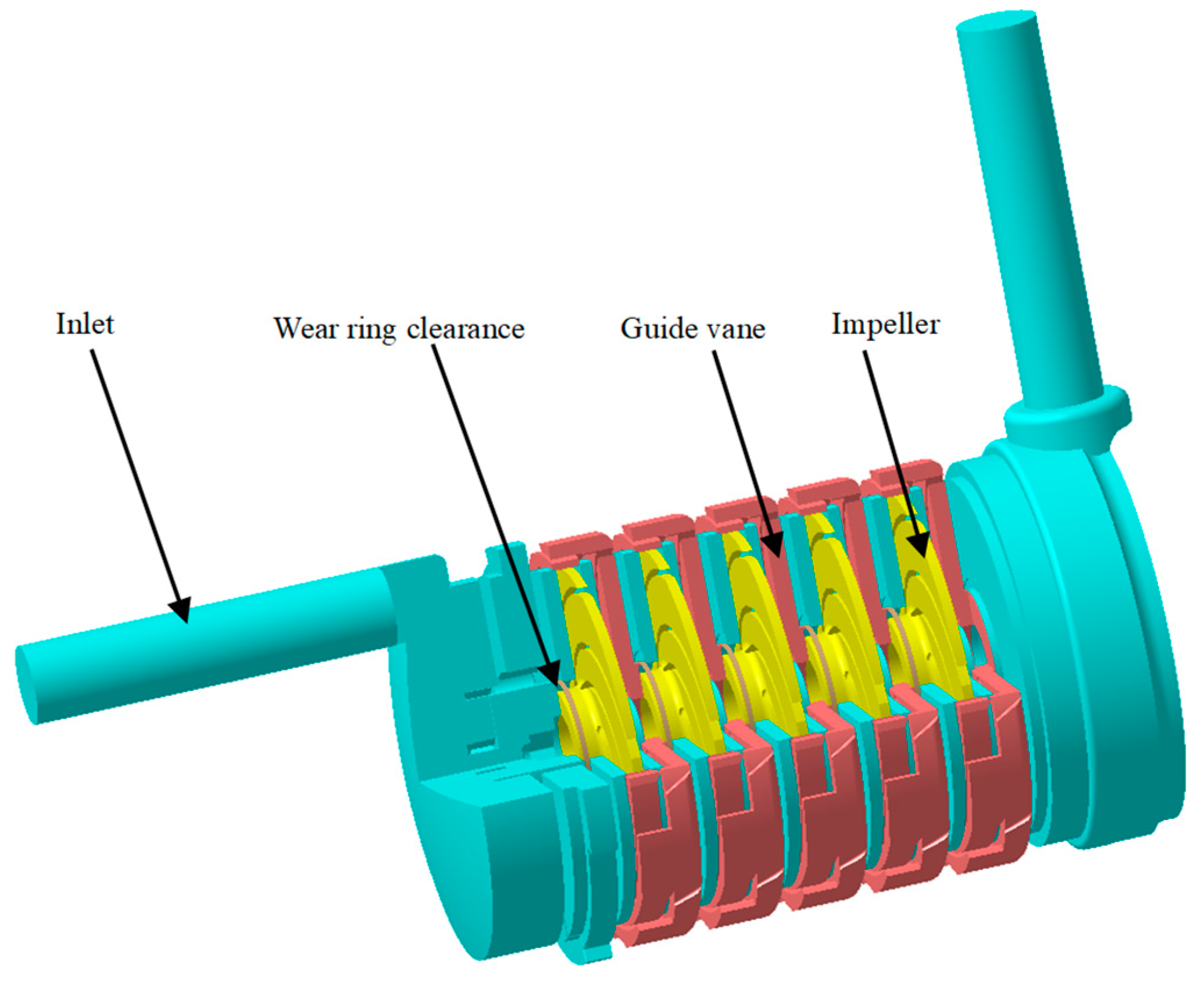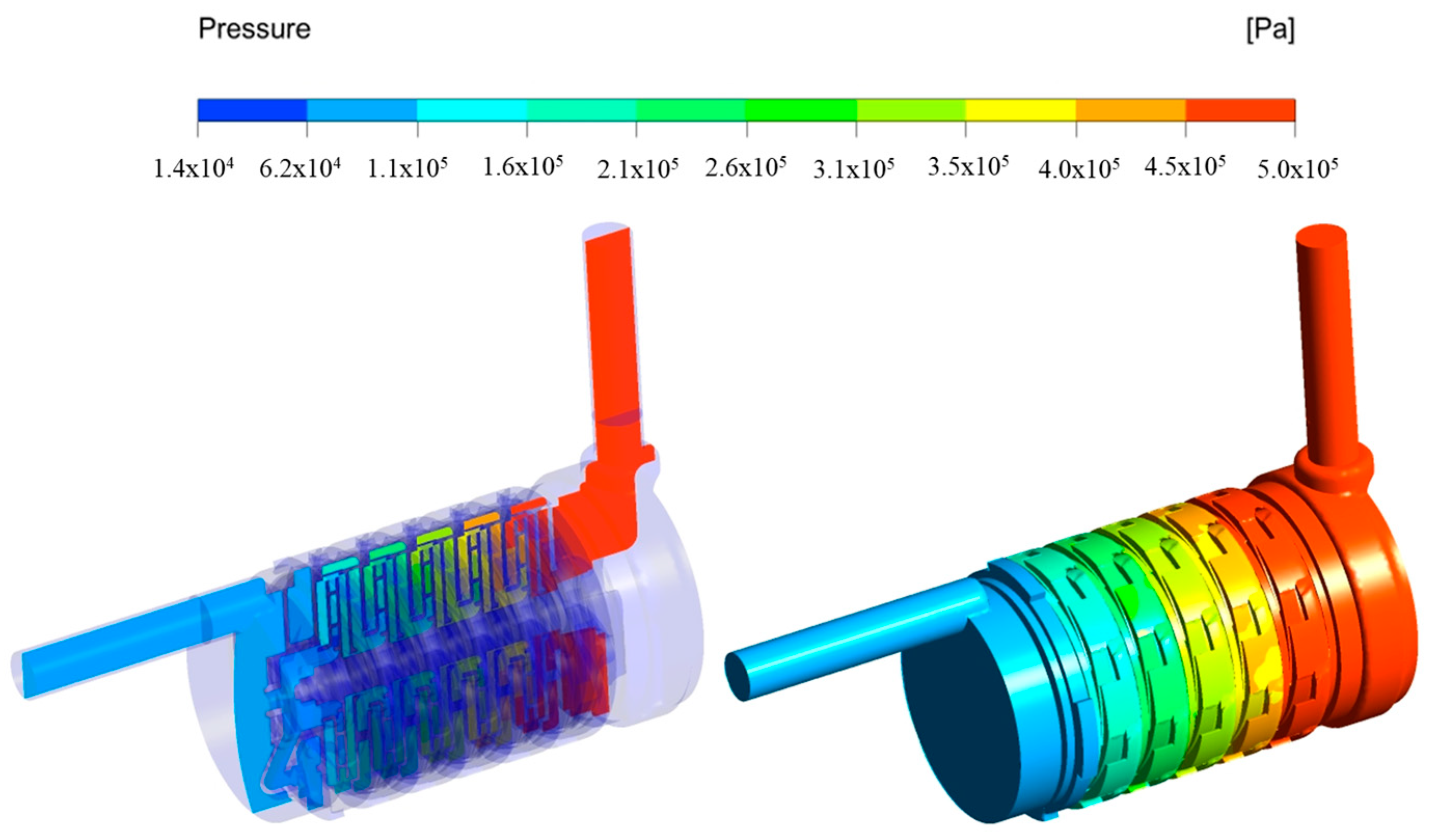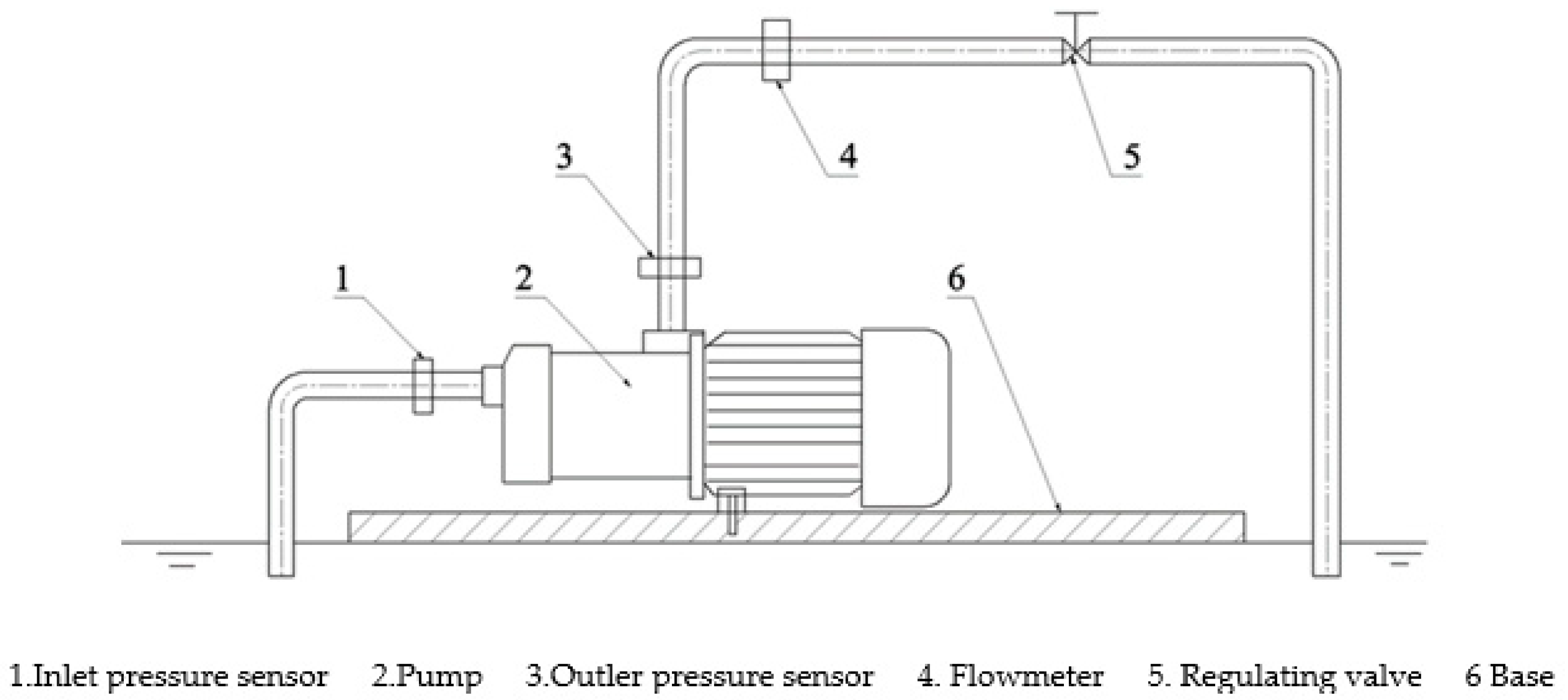Optimized Design of a Multistage Centrifugal Pump Based on Volumetric Loss Reduction by Auxiliary Blades
Abstract
:1. Introduction
2. Research Model
2.1. Computational Modeling
2.2. Mesh Generation
2.3. Setting Boundary Conditions and Selecting a Model
3. Numerical Calculation Verification and Analysis
3.1. Numerical Calculation Verification
3.2. Internal Flow Field Analysis
3.3. Throat Ring Leakage Analysis

4. Application of Tesla Valve Principle
4.1. Flow Field Analysis Based on Tesla Valve Principle
4.2. Design of a Novel Impeller Structure
4.3. Numerical Analysis
4.4. Analysis of Leakage at the Impeller Throat Ring
5. Experimental Validation and Analysis
5.1. Sample Fabrication
5.2. Experimental Results Analysis
6. Conclusions
- (1)
- In the seal design of the multistage centrifugal pump’ throat ring gap, the Tesla valve principle can be applied. Utilizing the auxiliary blade structure to generate fluid impact can reduce throat ring leakage, thereby decreasing the volumetric loss of the multistage centrifugal pump.
- (2)
- After the addition of auxiliary blades, the head of the multistage centrifugal pump will increase under the same flow rate. The larger the flow rate, the more the pump’s head increases.
- (3)
- As the auxiliary blades rotate, they enhance the energy loss of the water pump while reducing volumetric loss. When the impeller diameter is 103 mm, the thickness of the auxiliary blade is 1.3 mm; when the radial length of the auxiliary blade is 1/4 of the impeller blade’s, the efficiency of the entire pump can be improved.
- (4)
- Auxiliary blades can cause the optimal operating point of the multistage centrifugal pump to shift towards the direction of a larger flow rate, thus improving the hydraulic performance of the pump.
- (5)
- The leakage of the multistage centrifugal pump throat ring varies with changes in flow rate. The larger the flow rate, the lower the throat ring leakage.
Author Contributions
Funding
Data Availability Statement
Conflicts of Interest
References
- Yan, J.; Zuo, Z.; Guo, W.; Hou, H.; Zhou, X.; Chen, H. Influences of wear ring clearance leakage on performance of a small-scale pump. Proc. Inst. Mech. Eng. Part A J. Power Energy 2020, 234, 454–469. [Google Scholar] [CrossRef]
- He, X.; Gong, W.; Deng, J.; Li, J.; Liang, L. Influence of impeller tip clearance on the performance of centrifugal refrigeration compressor. J. Xi’an Jiaotong Univ. 2019, 53, 30–37. [Google Scholar]
- Yang, C.; Qiang, P.; An, S.; Xu, N.; Liu, J. Effects of wear-ring clearance on performance of high-speed cetrifugal pump. Drain. Irrig. Mach. Eng. 2012, 35, 18–24. [Google Scholar]
- Zhao, C.; Han, X.; Cui, Z. Numerical simiulations of flow characteristics of wear-ring clearance in the centrifugal pump. Chin. J. Ship Res. 2020, 15, 159–167. [Google Scholar]
- Zheng, X.; Bu, X.; Sun, Z.; Xi, G. Leakage Characteristics of Wear Ring Clearance in Liquid Qxygen Turbo Pump under Thermodanamic Effect. J. Xi’an Jiaotong Univ. 2022, 56, 145–155. [Google Scholar]
- DaqiqShirazi, M.; Torabi, R.; Riasi, A.; Nourbakhsh, S. The effect of wear ring clearance on flow field in the impeller sidewall gap and efficiency of a low specific speed centrifugal pump. Proc. Inst. Mech. Eng. Part C J. Mech. Eng. Sci. 2018, 232, 3062–3073. [Google Scholar] [CrossRef]
- Zhang, S.; Li, H.; Xi, D. Investigation of the integrated model of side chamber, wear rings clearance, and balancing holes for centrifugal pumps. J. Fluids Eng. 2019, 141, 101101. [Google Scholar] [CrossRef]
- Zheng, L.; Chen, X.; Zhang, W.; Zhu, Z.; Qu, J.; Wang, M.; Ma, X.; Cheng, X. Investigation on characteristics of pressure fluctuation in a centrifugal pump with clearance flow. J. Mech. Sci. Technol. 2020, 34, 3657–3666. [Google Scholar] [CrossRef]
- Yan, C.; Liu, J.; Zheng, S.; Huang, B.; Dai, J. Study on the effects of the wear rings clearance on the solid-liquid two-phase flow characteristics of centrifugal pumps. Symmetry 2020, 12, 2003. [Google Scholar] [CrossRef]
- Li, W.; Li, E.; Ji, L.; Zhou, L.; Shi, W.; Zhu, Y. Mechanism and propagation characteristics of rotating stall in a mixed-flow pump. Renew. Energy 2020, 153, 74–92. [Google Scholar] [CrossRef]
- Li, W.; Huang, Y.; Ji, L.; Ma, L.; Agarwal, R.K.; Awais, M. Prediction model for energy conversion characteristics during transient processes in a mixed-flow pump. Energy 2023, 271, 127082. [Google Scholar] [CrossRef]
- Ji, L.; Li, W.; Shi, W.; Chang, H.; Yang, Z. Energy Characteristics of Mixed-Flow Pump under Different Tip Clearances Based on Entropy Production Analysis. Energy 2020, 199, 117447. [Google Scholar] [CrossRef]
- Ji, L.; Li, W.; Shi, W.; Tian, F.; Agarwal, R. Effect of Blade Thickness on Rotating Stall of Mixed-Flow Pump Using Entropy Generation Analysis. Energy 2021, 236, 121381. [Google Scholar] [CrossRef]
- Ji, L.; Li, W.; Shi, W.; Tian, F.; Agarwal, R. Diagnosis of internal energy characteristics of mixed-flow pump within stall region based on entropy production analysis model. Int. Commun. Heat Mass Transf. 2020, 117, 104784. [Google Scholar] [CrossRef]
- Ji, L.; He, S.; Li, W.; Shi, W.; Li, S.; Li, H.; Agarwal, R. Exploration of Blade Thickness in Suppressing Rotating Stall of Mixed Flow Pump. Arab. J. Sci. Eng. 2023, 48, 8227–8251. [Google Scholar] [CrossRef]
- Ji, L.; He, S.; Li, Y.; Li, W.; Shi, W.; Li, S.; Yang, Y.; Gao, Y.; Agarwal, R.K. Investigation of energy loss mechanism of shroud region in A mixed-flow pump under stall conditions. Proc. Inst. Mech. Eng. Part A J. Power Energy 2023, 09576509231162165. [Google Scholar] [CrossRef]
- Li, W.; Liu, M.; Ji, L.; Li, S.; Song, R.; Wang, C.; Cao, W.; Agarwal, R.K. Study on the trajectory of tip leakage vortex and energy characteristics of mixed-flow pump under cavitation conditions. Ocean Eng. 2023, 267, 113225. [Google Scholar] [CrossRef]
- Liu, H.; Du, X.; Wu, X.; Tan, M. Numerical simulation on gas-phase characteristics of gas-liquid two-phase flow in pump. J. Drain. Irrig. Mach. Eng. 2022, 40, 238–243. [Google Scholar]
- Liu, Z.; Zhang, Y.; Dai, Q.; Zheng, Y.; Wu, D.; Wei, W. Pressure pulsation characteristics and improvement methods of axial extension pump. J. Drain. Irrig. Mach. Eng. 2022, 40, 8–14. [Google Scholar]
- Kong, D.; Pan, Z.; Yang, B. Characteristics of gas-liquid two-phase flow in self-priming pump. J. Drain. Irrig. Mach. Eng. 2022, 40, 15–21. [Google Scholar]
- Stel, H.; Ofuchi, E.M.; Chiva, S.; Morales, R.E. Numerical simulation of gas-liquid flows in a centrifugal rotor. Chem. Eng. Sci. 2020, 221, 115692. [Google Scholar] [CrossRef]
- Huang, J.; Zheng, Y.; Kan, K.; Xu, Z.; Huang, C.; Zhou, G.; Du, Y. Hydraulic characteristics of reverse power generation of axial-flow pump. J. Drain. Irrig. Mach. Eng. 2022, 40, 230–237. [Google Scholar]
- Fu, J.; Li, H.; Fan, D.; Shen, W.; Liu, X. Modeling and Efficiency Prediction of Aeroengine Centrifugal Pump Integrated Loss Model Based on One-Dimensional Flow. J. Northwestern Polytech. Univ. 2018, 36, 807–815. [Google Scholar] [CrossRef]
- Gamboa, A.R.; Morris, C.J.; Forster, F.K. Improvements in fixed valve micropump performance through shape optimization of vlaves. J. Fluids Eng. 2005, 127, 339. [Google Scholar] [CrossRef]
- Wang, T.; Wang, H.; Lin, Y.; Chen, M.; Qian, J. Numerial study of hydrodynamic cavitation in Tesla valves. J. Chem. Eng. Chin. Univ. 2020, 34, 884–889. [Google Scholar]
- Tesla, N. Valvular Conduit. U.S. Patent 1,329,559, 3 February 1920. [Google Scholar]
- Mcdonald, J.C.; Duffy, D.C.; Anderson, J.R.; Chiu, D.T.; Wu, H.; Schueller, O.J.; Whitesides, G.M. Fabrication of microfluidic system in poly (dimethylsiloxane). Electrophoresis 2015, 21, 27–40. [Google Scholar] [CrossRef]
- Weng, X.; Yan, S.; Zhang, Y.; Liu, J.; Shen, J. Design, simulation and experimental study of a micromixter based on Tesla valve structure. Chem. Ind. Eng. Prog. 2021, 40, 4173–4178. [Google Scholar]
- Zhou, R.; Qiao, Y.; Zhang, Y.; Dai, Z. Simulating the performance of Tesla valve. Phys. Exp. 2020, 40, 44–50. [Google Scholar]


















| Leakage of Original Scheme | ||||||||||||
|---|---|---|---|---|---|---|---|---|---|---|---|---|
| Flow Rate Q m3/h | 0.00 | 1.56 | 2.38 | 3.16 | 3.70 | 4.03 | 4.38 | 4.69 | 4.97 | 5.16 | 5.36 | |
| Leakage Rate kg/s | Level 1 | 0.47 | 0.39 | 0.37 | 0.35 | 0.32 | 0.30 | 0.27 | 0.25 | 0.22 | 0.21 | 0.18 |
| Level 2 | 0.46 | 0.37 | 0.35 | 0.34 | 0.32 | 0.30 | 0.27 | 0.25 | 0.22 | 0.20 | 0.18 | |
| Level 3 | 0.47 | 0.36 | 0.35 | 0.34 | 0.32 | 0.30 | 0.28 | 0.25 | 0.22 | 0.20 | 0.18 | |
| Level 4 | 0.47 | 0.36 | 0.35 | 0.34 | 0.32 | 0.30 | 0.27 | 0.25 | 0.22 | 0.20 | 0.18 | |
| Level 5 | 0.49 | 0.36 | 0.35 | 0.33 | 0.32 | 0.30 | 0.27 | 0.25 | 0.22 | 0.20 | 0.18 | |
| All | 2.36 | 1.84 | 1.76 | 1.69 | 1.60 | 1.51 | 1.37 | 1.24 | 1.10 | 1.00 | 0.89 | |
| Serial Number | Flow Rate Q m3/h | Leakage Rate-Without Auxiliary Blade kg/s | Leakage Rate-With Auxiliary Blade kg/s | Amount of Leakage Reduction kg/s | Leakage Reduction Rate % |
|---|---|---|---|---|---|
| 1 | 5.36 | 0.89 | 0.64 | 0.26 | 28.99 |
| 2 | 5.16 | 1.00 | 0.75 | 0.25 | 24.60 |
| 3 | 4.97 | 1.10 | 0.85 | 0.25 | 22.59 |
| 4 | 4.69 | 1.24 | 0.99 | 0.25 | 20.25 |
| 5 | 4.38 | 1.37 | 1.11 | 0.27 | 19.35 |
| 6 | 4.03 | 1.51 | 1.23 | 0.29 | 18.89 |
| 7 | 3.70 | 1.60 | 1.32 | 0.29 | 17.97 |
| 8 | 3.16 | 1.69 | 1.42 | 0.26 | 15.60 |
| 9 | 2.38 | 1.76 | 1.52 | 0.24 | 13.74 |
| 10 | 1.56 | 1.84 | 1.68 | 0.16 | 8.57 |
| 11 | 0.00 | 2.36 | 2.18 | 0.18 | 7.70 |
Disclaimer/Publisher’s Note: The statements, opinions and data contained in all publications are solely those of the individual author(s) and contributor(s) and not of MDPI and/or the editor(s). MDPI and/or the editor(s) disclaim responsibility for any injury to people or property resulting from any ideas, methods, instructions or products referred to in the content. |
© 2023 by the authors. Licensee MDPI, Basel, Switzerland. This article is an open access article distributed under the terms and conditions of the Creative Commons Attribution (CC BY) license (https://creativecommons.org/licenses/by/4.0/).
Share and Cite
Gao, Y.; Li, W.; Qi, H.; Ji, L.; Chen, Y. Optimized Design of a Multistage Centrifugal Pump Based on Volumetric Loss Reduction by Auxiliary Blades. Water 2023, 15, 2350. https://doi.org/10.3390/w15132350
Gao Y, Li W, Qi H, Ji L, Chen Y. Optimized Design of a Multistage Centrifugal Pump Based on Volumetric Loss Reduction by Auxiliary Blades. Water. 2023; 15(13):2350. https://doi.org/10.3390/w15132350
Chicago/Turabian StyleGao, Yi, Wei Li, Handong Qi, Leilei Ji, and Yunfei Chen. 2023. "Optimized Design of a Multistage Centrifugal Pump Based on Volumetric Loss Reduction by Auxiliary Blades" Water 15, no. 13: 2350. https://doi.org/10.3390/w15132350
APA StyleGao, Y., Li, W., Qi, H., Ji, L., & Chen, Y. (2023). Optimized Design of a Multistage Centrifugal Pump Based on Volumetric Loss Reduction by Auxiliary Blades. Water, 15(13), 2350. https://doi.org/10.3390/w15132350








